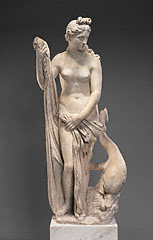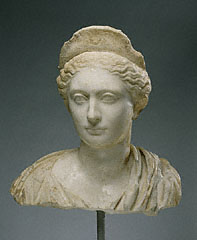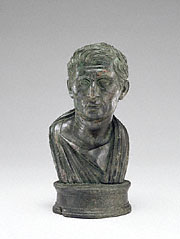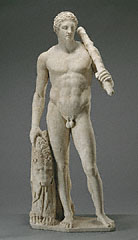 |
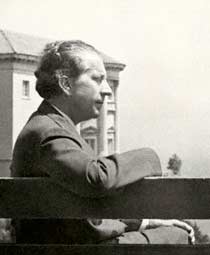
 |
 |
J. Paul Getty at Inspiration Point, Malibu, 1947
|
 |
 |
|
J. Paul Getty acquired his first work of art, a painting, in 1931. While most thought that the golden age of collecting was over, the oil magnate realized the opportunities of the Great Depression and avidly began looking at art.
Drawn from the collections of the Museum and Research Institute, this exhibition features sculptures, frescoes, mosaics, engravings, photographs, and letters, and explores the founder's personality and taste as a collector.
Getty's interest was threefold: decorative arts, old master paintings, and classical antiquities. As he became one of the wealthiest people in the world, Getty gradually developed an important collection of Greek and Roman art.
His passion for ancient art—and history—culminated in the striking decision to build a museum modeled on an ancient Roman villa.
|
 |
|
In the 1930s and 1950s business matters kept Getty out of the United States for extended periods. Long years in Europe acquainted him with aristocratic families and their ways of life. He bought estates with rich histories in England and Italy.
Works of art with colorful pasts presented a particular charm, and he obtained numerous sculptures with esteemed provenances, or histories of ownership, such as the Mazarin Venus. He also purchased works once owned by Thomas Bruce, seventh Earl of Elgin, known for obtaining marble sculptures from the Parthenon in Athens.
|
 |
|
Getty was particularly drawn to marble statuary as the most enduring and accomplished expression of ancient artistry. He did not care much for Greek portraiture, which, in his distinctive candor, he called "boring"; he preferred the realism of Roman portraits. He also liked large elements of architectural decoration, such as mosaics and frescoes.
Getty based his initial interest in an object on its aesthetic appeal. A penchant for images of eternal youth and beauty attracted him to ancient statues of heroes and divinities, among which Hercules and Venus became his favorites. This sentimental approach also made him partial to depictions of children and animals.
|
 |
|
Throughout his collecting career, J. Paul Getty consulted noted experts in the field of antiquities. As early as 1939 renowned scholars accompanied him on his visits to art galleries and archaeological sites in Italy.
But it was with Jean Charbonneaux and Bernard Ashmole, curators of Greek and Roman antiquities at the Louvre and the British Museum respectively, that Getty had the most fruitful relationships. Ashmole wrote in his autobiography that he was impressed with Getty's "genuine interest in and knowledge of Greek sculpture." Ashmole encouraged Getty to purchase the Bust of Menander, an object about which he had made an important discovery.
|
 |
|
In 1968 Getty decided to erect a new building on his Malibu property to hold his growing art collection. He ultimately wanted to re-create the Villa dei Papiri, a luxurious Roman country house in Herculaneum buried by the eruption of Mount Vesuvius in A.D. 79. His diaries reveal visits to archaeological sites around the Bay of Naples, and he bought two Italian properties that included the remains of ancient villas.
In his 1955 novella A Journey from Corinth, Getty had featured the Villa dei Papiri as the imaginary home of one of his favorite works in his collection, the Lansdowne Herakles (on view in the permanent collection galleries). The new museum opened to the public in 1974, but Getty was not able to see it before his death.
|
 |

